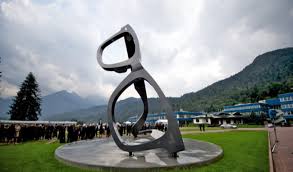
To create a global powerhouse in the eyewear industry with annual revenue of more than 15 billion euros, Italy's Luxottica and France's Essilor have agreed a 46 billion euro ($49 billion) merger.
While Essilor is the world's leading manufacturer of ophthalmic lenses, Luxottica, the world's top spectacles maker with brands such as Oakley and Ray-Ban and the deal which is one of Europe's largest cross-border tie-ups, will brings h3ese two companies together.
"Finally ... two products which are naturally complementary -- namely frames and lenses -- will be designed, manufactured and distributed under the same roof," Luxottica's 81-year-old founder Leonardo Del Vecchio said in a statement.
Due to an aging global population and increasing awareness about eye care in Asia and Latin America, the $95 billion market expected to achieve continued growth and the companies will be better positioned to take advantage of strong demand in the market by the merger.
Something in the range of 400 million euros to 600 million euros in the medium term is the expected annual revenue benefits and cost savings to the companies, they said.
The CEO and executive chairman of the merged EssilorLuxottica, which will be listed in Paris, will be Del Vecchio, who returned to the helm of Luxottica two years ago after taking a back seat for the previous decade.
The biggest shareholder of the new company would be Del Vecchio who will take a stake of between 31 percent and 38 percent in the merged group through his family holding Delfin. Voting rights will be capped at 31 percent.
The executive vice-chairman and deputy CEO, with the same powers as the chairman and CEO, will be Essilor Chairman and CEO Hubert Sagnieres.
The companies' combined operations will be able to offer a much faster service to their customers, said Sagnieres in a call with journalists on Monday.
1 share in the Italian group for every 0.461 Essilor shares would be the ratio at which that Delfin will contribute its 62 percent stake in Luxottica. With the aim of delisting Luxottica's shares, a mandatory exchange offer on all remaining Luxottica shares at the same ratio would be started by the French lens maker which is also a long-time supplier to the Italian group.
A possible tie-up a few years ago had been explored by Luxottica and Essilor, which have a market value of about 24 billion euros and 22 billion euros respectively.
Saying that at least 2.5 billion people in the world still suffer from uncorrected vision problems, the companies expect rapid growth in the global eyewear market.
Raising questions over Del Vecchio's succession plans and strategy, Luxottica has been dogged by management upheaval in recent years. Some insiders have said a merger could help settle such issues.
Del Vecchio tightened his grip on the group by taking on executive powers when Adil Mehboob-Khan, a former Procter & Gamble executive, stepped down after just 17 months in that position about a year ago at Luxottica.
After a rift with Del Vecchio, long-standing CEO Andrea Guerra quit in 2014. Also due to differences with Del Vecchio, Guerra’s successor, Enrico Cavatorta, left only six weeks into the job.
(Source:www.reuters.com)
While Essilor is the world's leading manufacturer of ophthalmic lenses, Luxottica, the world's top spectacles maker with brands such as Oakley and Ray-Ban and the deal which is one of Europe's largest cross-border tie-ups, will brings h3ese two companies together.
"Finally ... two products which are naturally complementary -- namely frames and lenses -- will be designed, manufactured and distributed under the same roof," Luxottica's 81-year-old founder Leonardo Del Vecchio said in a statement.
Due to an aging global population and increasing awareness about eye care in Asia and Latin America, the $95 billion market expected to achieve continued growth and the companies will be better positioned to take advantage of strong demand in the market by the merger.
Something in the range of 400 million euros to 600 million euros in the medium term is the expected annual revenue benefits and cost savings to the companies, they said.
The CEO and executive chairman of the merged EssilorLuxottica, which will be listed in Paris, will be Del Vecchio, who returned to the helm of Luxottica two years ago after taking a back seat for the previous decade.
The biggest shareholder of the new company would be Del Vecchio who will take a stake of between 31 percent and 38 percent in the merged group through his family holding Delfin. Voting rights will be capped at 31 percent.
The executive vice-chairman and deputy CEO, with the same powers as the chairman and CEO, will be Essilor Chairman and CEO Hubert Sagnieres.
The companies' combined operations will be able to offer a much faster service to their customers, said Sagnieres in a call with journalists on Monday.
1 share in the Italian group for every 0.461 Essilor shares would be the ratio at which that Delfin will contribute its 62 percent stake in Luxottica. With the aim of delisting Luxottica's shares, a mandatory exchange offer on all remaining Luxottica shares at the same ratio would be started by the French lens maker which is also a long-time supplier to the Italian group.
A possible tie-up a few years ago had been explored by Luxottica and Essilor, which have a market value of about 24 billion euros and 22 billion euros respectively.
Saying that at least 2.5 billion people in the world still suffer from uncorrected vision problems, the companies expect rapid growth in the global eyewear market.
Raising questions over Del Vecchio's succession plans and strategy, Luxottica has been dogged by management upheaval in recent years. Some insiders have said a merger could help settle such issues.
Del Vecchio tightened his grip on the group by taking on executive powers when Adil Mehboob-Khan, a former Procter & Gamble executive, stepped down after just 17 months in that position about a year ago at Luxottica.
After a rift with Del Vecchio, long-standing CEO Andrea Guerra quit in 2014. Also due to differences with Del Vecchio, Guerra’s successor, Enrico Cavatorta, left only six weeks into the job.
(Source:www.reuters.com)














